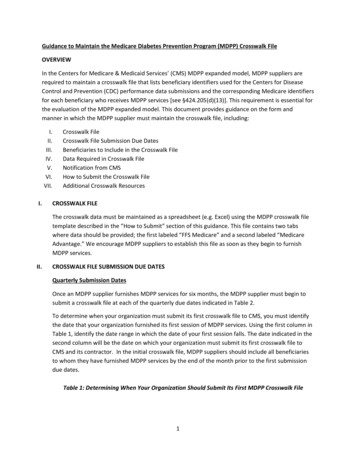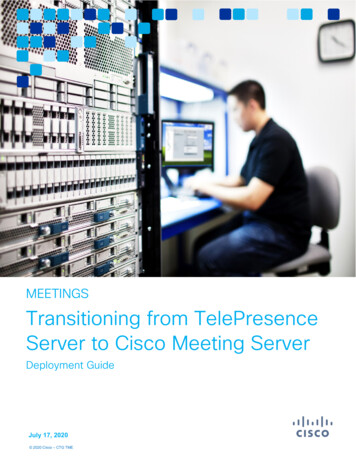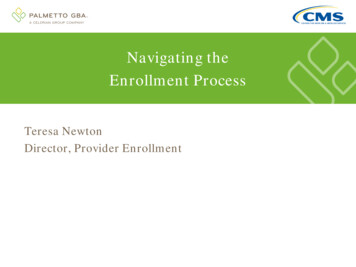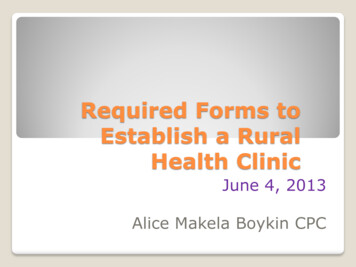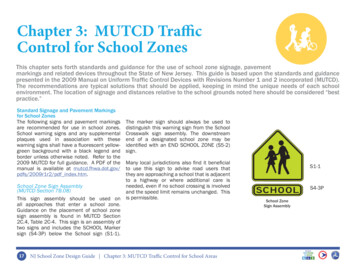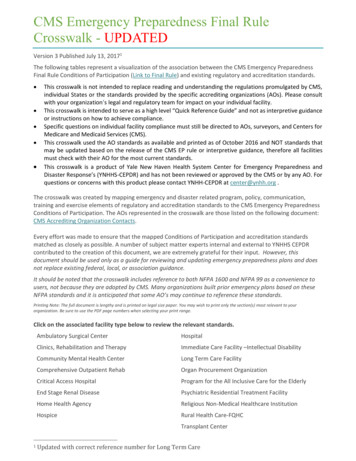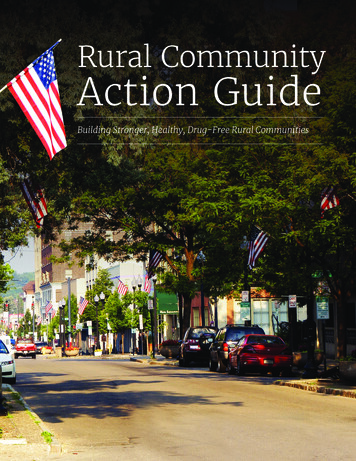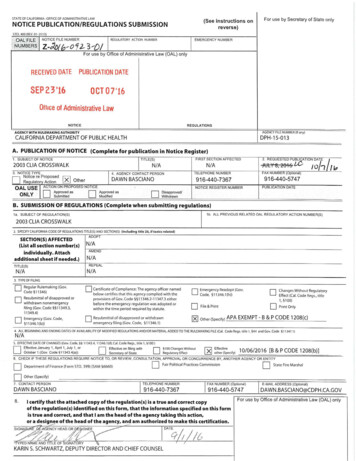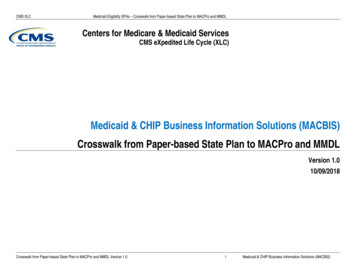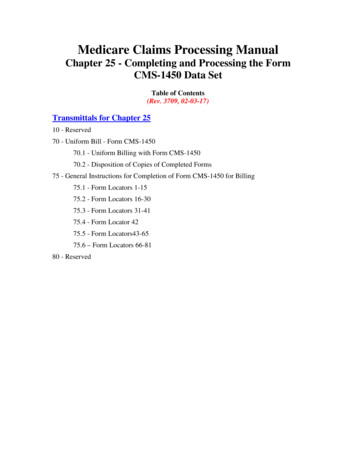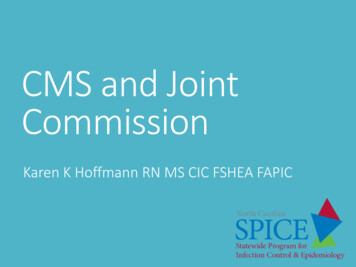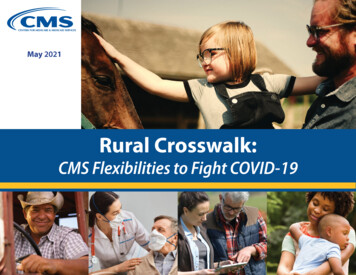
Transcription
May 2021Rural Crosswalk:CMS Flexibilities to Fight COVID-19
Paid for by the U.S. Department of Health and Human Services
Rural Crosswalk: CMS Flexibilities to Fight COVID-19Since the beginning of the COVID-19 Public Health Emergency (PHE), CMS has issued an unprecedented array of temporary regulatorywaivers and new rules to equip the American healthcare system with maximum flexibility to respond to the 2019 Novel Coronavirus (COVID19) pandemic. These temporary changes will apply immediately across the entire U.S. healthcare system for the duration of the emergencydeclaration. The goals of these actions are to 1) expand the healthcare system workforce by removing barriers for physicians, nurses, andother clinicians to be readily hired from the community or from other states; 2) ensure that local hospitals and health systems have thecapacity to handle a potential surge of COVID-19 patients through temporary expansion sites (also known as CMS Hospital Without Walls);3) increase access to telehealth in Medicare to ensure patients have access to physicians and other clinicians while keeping patients safe athome; 1 4) expand in-place testing to allow for more testing at home or in community based settings; and 5) put Patients Over Paperwork togive temporary relief from many paperwork, reporting and audit requirements so providers, health care facilities, Medicare Advantage andPart D plans, and States can focus on providing needed care to Medicare and Medicaid beneficiaries affected by COVID-19.This document highlights COVID-19 related provisions that CMS has issued and/or carried out during the Public Health Emergency (PHE)that impact Rural Health Clinics (RHCs), Federally Qualified Health Centers (FQHCs), Critical Access Hospitals (CAHs), Rural Acute CareProspective Payment System (PPS) Hospitals, and/or Medicare-certified Skilled Nursing Facilities (SNFs).** Indicates items added or revised in the most recent updateTable of ContentsTelehealth and Other Virtual Services .2CMS Hospital Without Walls (Temporary Expansion Sites) .5CMS Facility Without Walls (Temporary Expansion Sites) .11Patients Over Paperwork .14Workforce .23Payment .29Data Reporting .36Additional Guidance .38Telehealth and other virtual services are furnished by eligible clinicians paid under the Physician Fee Schedule. This document outlines telehealth andother virtual service waivers that affect clinicians practicing in the types of facilities included or who may have reassigned their billing rights to thesefacilities.1May 20211
Rural Crosswalk: CMS Flexibilities to Fight COVID-19Telehealth and Other Virtual ServicesTelehealth and Other Virtual FBeneficiaryLocation forTelehealthServicesMedicare can pay for many types of office, hospital, and other visits furnished viatelehealth across the country and including in patient’s places of residence.Additionally, the HHS OIG is providing flexibility for healthcare providers to reduce orwaive cost-sharing for telehealth visits paid by federal healthcare programs. 2YesYesYesYesNoAdditionalTelehealthServicesCovered byMedicareClinicians are allowed to provide more than 135 new telehealth services, including:emergency department visits, initial and subsequent observation, initial hospital careand hospital discharge day management, initial nursing facility visits, critical careservices, intensive care services, therapy services. 3 On October 14, 2020, using anew expedited process, CMS added 11 new services to the Medicare telehealthservices list. Medicare will begin paying eligible practitioners who furnish these newlyadded telehealth services effective immediately and for the duration of the PHE.These new telehealth services include certain neurostimulator analysis andprogramming services, and cardiac and pulmonary rehabilitation services.YesYesYesYesYesVirtual CheckIns, RemoteEvaluations, &E-VisitsClinicians can provide virtual check-in, remote evaluation of patient-submittedvideo/images, and e-visit services to both new and established patients. Theseservices were previously limited to established patients. Licensed clinical socialworkers, clinical psychologists, physical therapists, occupational therapists, andspeech language pathologists can provide e-visits, virtual check-ins, and remoteevaluations. A broad range of clinicians, including physicians, can now provide certainservices by telephone to their patients.YesYesYesYesNoRemote PatientMonitoringClinicians can provide remote patient monitoring services to both new and establishedpatients. These services can be provided for both acute and chronic conditions andcan now be provided for patients with only one disease. 4YesYesYesYesNoMore information on this flexibility can be found here: 2020/factsheet-telehealth-2020.pdfA complete list of all Medicare telehealth services can be found here: mation/Telehealth/Telehealth-Codes4More information on this flexibility can be found here: .pdf23May 20212
Rural Crosswalk: CMS Flexibilities to Fight COVID-19Telehealth and Other Virtual ServicesFlexibilityRHCFQHCCAHHospitalSNFRemoval ofFrequencyLimitations onMedicareTelehealthThe following services no longer have limitations on the number of times they can beprovided by Medicare telehealth: A subsequent inpatient visit can be furnished via Medicare telehealth, without thelimitation that the telehealth visit is once every three days; A subsequent SNF visit can be furnished via Medicare telehealth, without thelimitation that the telehealth visit is once every 30 days; Critical care consult codes may be furnished to a Medicare beneficiary bytelehealth beyond the once per day limitation.NoNoYesYesYesEligiblePractitionersCMS is waiving the requirements of section 1834(m)(4)(E) of the Social Security Actand 42 CFR § 410.78 (b)(2) which specify the types of practitioners that may bill fortheir services when furnished as Medicare telehealth services from the distant site.The waiver of these requirements expands the types of health care professionals thatcan furnish distant site telehealth services to include all those that are eligible to billMedicare for their professional services. This allows health care professionals whowere previously ineligible to furnish and bill for Medicare telehealth services, includingphysical therapists, occupational therapists, speech language pathologists, andothers, to receive payment for Medicare telehealth services.YesYesYesYesYesPractitionerLocationsCMS is waiving the Medicare requirement that a physician or non-physicianpractitioner must be licensed in the State in which s/he is practicing for individuals forwhom the following four conditions are met: 1) must be enrolled as such in theMedicare program, 2) must possess a valid license to practice in the State whichrelates to his or her Medicare enrollment, 3) is furnishing services – whether in personor via telehealth – in a State in which the emergency is occurring in order to contributeto relief efforts in his or her professional capacity, and 4) is not affirmatively excludedfrom practice in the State or any other State that is part of the 1135 emergency area.YesYesYesYesYesAllowing FQHCsand RHCs toServe as DistantSites forTelehealthFQHCs and RHCs may serve as distant site practitioners to furnish telehealthservices. Medicare pays for these telehealth services based on payment rates similarto the national average payment rates for comparable telehealth services under theMedicare Physician Fee Schedule. These services are excluded from both the FQHCprospective payment system and the RHC all-inclusive rate calculation.YesYesNoNoNoPhysician Visitsin SNFs/NursingFacilitiesCMS is waiving the requirement in 42 CFR 483.30 for physicians and non-physicianpractitioners to perform in-person visits for nursing home residents and allow visits tobe conducted, as appropriate, via telehealth options.NoNoNoNoYesMay 2021Description3
Rural Crosswalk: CMS Flexibilities to Fight COVID-19Telehealth and Other Virtual FAudio-OnlyTelehealth forCertain ServicesCMS is waiving the requirements of section 1834(m)(1) of the Social Security Act and42 CFR § 410.78(a)(3) for use of interactive telecommunications systems to furnishtelehealth services, to the extent they require use of video technology, for certainservices. This waiver allows the use of audio-only equipment to furnish servicesdescribed by the codes for audio-only telephone evaluation and managementservices, and behavioral health counseling and educational rBilling (revised)During the COVID-19 PHE, non-physician practitioners who are eligible to billMedicare directly, including registered dietitians and nutrition professionals, may billfor audio-only telephone assessment and management services: CPT codes 9896698968 (Dates of service on or after March 1 until the end of the PHE).YesYesYesYesNoHospitalOutpatient FeesAccompanyingProfessionalServicesFurnished ViaTelehealthWhen a physician or non-physician practitioner who typically furnishes professionalservices in the hospital outpatient department furnishes telehealth services during theCOVID-19 PHE, they bill with a hospital outpatient place of service since that is likelywhere the services would have been furnished if not for the COVID-19 PHE. Thephysician or practitioner is paid for the service under the PFS at the facility rate, whichdoes not include payment for resources such as clinical staff, supplies, or officeoverhead since those things are usually supplied by the hospital outpatientdepartment. During the COVID-19 PHE, if the beneficiary’s home or temporaryexpansion site is considered to be a provider-based department of the hospital, andthe beneficiary is registered as an outpatient of the hospital for purposes of receivingtelehealth services billed by the physician or practitioner, the hospital may bill underthe PFS for the originating site facility fee associated with the telehealth service.NoNoYesYesNoMay 20214
Rural Crosswalk: CMS Flexibilities to Fight COVID-19CMS Hospital Without Walls (Temporary Expansion Sites)CMS Hospital Without Walls (Temporary Expansion ospitals Ableto Provide Carein TemporaryExpansion SitesAs part of the CMS Hospital Without Walls initiative, hospitals can provide hospitalservices in other healthcare facilities and sites that would not otherwise be consideredto be part of a healthcare facility (such facilities would be re-enrolled as hospitals); orcan set up temporary expansion sites to help address the urgent need to increasecapacity to care for patients. In the absence of waivers, hospitals are generallyrequired to provide services to patients within their hospital departments.NoNoYesYesNoOff Site PatientScreeningCMS is waiving the enforcement of section 1867(a) of the Social Security Act (theEmergency Medical Treatment and Active Labor Act, or EMTALA). This will allowhospitals, psychiatric hospitals, and CAHs to screen patients at a location offsite fromthe hospital’s campus to prevent the spread of COVID-19, so long as it is notinconsistent with the state emergency preparedness or pandemic equirementsPhysicalEnvironment(Hospitals)May 2021CMS is waiving certain specific paperwork requirements under this section only forhospitals which are considered to be impacted by a widespread outbreak of COVID19. This allows hospitals to establish COVID-19 specific areas. Hospitals that arelocated in a state that has widespread confirmed cases would not be required to meetthe following requirements: 42 CFR §482.13(d)(2) with respect to timeframes in providing a copy of a medicalrecord. 42 CFR §482.13(h) related to patient visitation, including the requirement to havewritten policies and procedures on visitation of patients who are in COVID-19isolation and quarantine processes. 42 CFR §482.13(e)(1)(ii) regarding seclusion.CMS is waiving certain physical environment requirements under the Medicareconditions of participation at 42 CFR §482.41 and 42 CFR §485.623 to allow forincreased flexibilities for surge capacity and patient quarantine at hospitals,psychiatric hospitals, and CAHs as a result of COVID-19. CMS will permit facility andnon-facility space that is not normally used for patient care to be utilized for patientcare or quarantine, provided the location is approved by the state (ensuring thatsafety and comfort for patients and staff are sufficiently addressed) and is consistentwith the state’s emergency preparedness or pandemic plan. States are still subject toobligations under the integration mandate of the Americans with Disabilities Act, toavoid subjecting persons with disabilities to unjustified institutionalization orsegregation.5
Rural Crosswalk: CMS Flexibilities to Fight COVID-19CMS Hospital Without Walls (Temporary Expansion ospitalOutpatient: Useof ProviderBasedDepartments asTemporaryExpansion SitesFor the duration of the PHE related to COVID-19, CMS is waiving certainrequirements under the Medicare conditions of participation at 42 CFR §482.41 and§485.623 and the provider-based department requirements at 42 CFR §413.65 toallow hospitals to establish and operate as part of the hospital any location meetingthe conditions of participation for hospitals in operation during the PHE. This waiveralso allows hospitals to change the status of their current provider-based departmentlocations to the extent necessary to address the needs of hospital patients as part ofthe state or local pandemic plan. CMS also is offering some additional flexibilities tofurnish inpatient services under arrangements. These changes include: 5 Adopting a temporary extraordinary circumstances relocation exception policy foron-campus PBDs and excepted off-campus PBDs that are relocating off-campusduring the COVID-19 PHE. Under our existing extraordinary relocation exceptionpolicy, only relocating off-campus PBDs are eligible to request this exception. Streamlining the process during the COVID-19 PHE for relocating PBDs to seekthe extraordinary circumstances exception so they can start seeing patients andbilling for services immediately in the relocated PBD. Allowing PBDs to relocate into more than one PBD location, and allowing PBDs topartially relocate while still maintaining the original location. Hospitals can relocatePBDs to the patient’s home and continue to receive the full OPPS paymentamount under the extraordinary circumstances relocation exception policy.NoNoYesYesNoCAH Length ofStayCMS is waiving the Medicare requirements that CAHs limit the number of beds to 25,and that the length of stay be limited to 96 hours under the Medicare conditions ofparticipation regarding number of beds and length of stay at 42 CFR §485.620.NoNoYesNoNoCAH Status andLocationCMS is waiving the requirement at 485.610(b) that the CAH be located in a rural areaor an area being treated as rural, allowing the CAHs flexibility in the establishment ofsurge site locations. Waiving the requirement at 485.610(e) regarding off-campus andco-location requirements allows the CAH flexibility in establishing off-site locations. Inan effort to facilitate the establishment of CAHs without walls, these waivers willremove restrictions on CAHs regarding their rural location and their location relative toother hospitals and CAHs. These flexibilities should be implemented so long as it isnot inconsistent with State or emergency or pandemic plan.NoNoYesNoNoMore information on this flexibility can be found here: y 20216
Rural Crosswalk: CMS Flexibilities to Fight COVID-19CMS Hospital Without Walls (Temporary Expansion Sites)FlexibilityHousing AcuteCare Patients inExcludedDistinct PartUnitsTelemedicineInspection,Testing &Maintenance(ITM) under thePhysicalEnvironmentConditions y andEducationServicesHospital OnlyClinical Staff InPerson ServicesMay 2021DescriptionCMS is waiving requirements to allow acute care hospitals to house acute careinpatients in excluded distinct part units, where the distinct part unit’s beds areappropriate for acute care inpatients. The Inpatient Prospective Payment System(IPPS) hospital should bill for the care and annotate the patient’s medical record toindicate the patient is an acute care inpatient being housed in the excluded unitbecause of capacity issues related to the disaster or emergency.CMS is waiving the provisions related to telemedicine for hospitals and CAHs at 42CFR 482.12(a)(8)-(9) and 42 CFR 485.616(c), making it easier for telemedicineservices to be furnished to the hospital’s patients through an agreement with an offsite hospital. This allows for increased access to necessary care for hospital and CAHpatients, including access to specialty MS is waiving certain physical environment requirements for Hospitals, CAHs,inpatient hospice, ICF/IIDs, and SNFs/NFs to reduce disruption of patient care andpotential exposure/transmission of COVID-19. The physical environment regulationsrequire that facilities and equipment be maintained to ensure an acceptable level ofsafety and quality. CMS will permit facilities to adjust scheduled inspection, testingand maintenance (ITM) frequencies and activities for facility and medical equipment.NoNoYesYesYesHospitals may bill for services furnished remotely by hospital-based practitioners toMedicare patients registered as hospital outpatients, including when the patient is athome when the home is serving as a temporary provider based department of thehospital. Examples of such services include counseling and educational services aswell as therapy services.NoNoYesYesNoHospital clinical staff must furnish certain services such as infusions and wound carein person given the nature of the services. Under interim final regulations andHospitals without Walls: the beneficiary’s home can be considered a provider-based department of thehospital for purposes of receiving outpatient services and the beneficiary would beregistered as a hospital outpatient. the hospital may bill for these services as hospital outpatient services, providedthe PBD is an on campus or excepted off-campus PBD that relocated to thepatient’s home consistent with the extraordinary circumstances relocationexception policy.NoNoYesYesNo7
Rural Crosswalk: CMS Flexibilities to Fight COVID-19CMS Hospital Without Walls (Temporary Expansion xpandedAbility forHospitals toOffer Long-termCare Services(“Swing-Beds”)Under section 1135(b)(1) of the Act, CMS is waiving the requirements at 42 CFR482.58, “Special Requirements for hospital providers of long-term care services(“swing-beds”)” subsections (a)(1)-(4) “Eligibility”, to allow hospitals to establish SNFswing beds payable under the SNF prospective payment system (PPS) to provideadditional options for hospitals with patients who no longer require acute care but areunable to find placement in a SNF. This waiver applies to all Medicare enrolledhospitals, except psychiatric and long term care hospitals that need to provide posthospital SNF level swing-bed services for nonacute care patients in hospitals, so longas the waiver is not inconsistent with the state’s emergency preparedness orpandemic plan. The hospital shall not bill for SNF PPS payment using swing bedswhen patients require acute level care or continued acute care at any time while thiswaiver is in effect. This waiver is permissible for swing bed admissions during theCOVID-19 PHE with an understanding that the hospital must have a plan to dischargeswing bed patients as soon as practicable, when a SNF bed becomes available, orwhen the PHE ends, whichever is earlier.NoNoNoYesNoCMS is waiving certain eligibility requirements at 42 CFR § 412.92(a) for hospitalsclassified as SCHs prior to the PHE. Specifically, CMS is waiving the distancerequirements at paragraphs (a), (a)(1), (a)(2), and (a)(3) of 42 CFR § 412.92, and isalso waiving the “market share” and bed requirements (as applicable) at 42 CFR §412.92(a)(1)(i) and (ii).NoNoNoYesNoFor hospitals classified as MDHs prior to the PHE, CMS is waiving the eligibilityrequirement at 42 CFR § 412.108(a)(1)(ii) that the hospital has 100 or fewer bedsduring the cost reporting period, and the eligibility requirement at 42 CFR §412.108(a)(1)(iv)(C) that at least 60 percent of the hospital's inpatient days ordischarges were attributable to individuals entitled to Medicare Part A benefits duringthe specified hospital cost reporting periods.NoNoNoYesNoHospitalsClassified asSole CommunityHospitals(SCHs)HospitalsClassified asMedicareDependent,Small RuralHospitals(MDHs)May 20218
Rural Crosswalk: CMS Flexibilities to Fight COVID-19CMS Hospital Without Walls (Temporary Expansion Sites)FlexibilitySpecific LifeSafety Code(LSC) spensersSpecific LifeSafety Code(LSC) forMultipleProviders:Fire DrillsMay 2021DescriptionCMS is waiving and modifying particular waivers under 42 CFR §482.41(b) forhospitals; §485.623(c) for CAHs; §418.110(d) for inpatient hospice; §483.470(j) forICF/IIDs and §483.90(a) for SNF/NFs. Specifically, CMS is modifying theserequirements as follows:Alcohol-based Hand-Rub (ABHR) Dispensers: We are waiving the prescriptiverequirements for the placement of alcohol based hand rub (ABHR) dispensers for useby staff and others due to the need for the increased use of ABHR in infection control.However, ABHRs contain ethyl alcohol, which is considered a flammable liquid, andthere are restrictions on the storage and location of the containers. This includesrestricting access by certain patient/resident population to prevent accidentalingestion. Due to the increased fire risk for bulk containers (over five gallons) thosewill still need to be stored in a protected hazardous materials area. Refer to: 2012LSC, sections 18/19.3.2.6. In addition, facilities should continue to protect ABHRdispensers against inappropriate use as required by 42 CFR §482.41(b)(7) forhospitals; §485.623(c)(5) for CAHs; §418.110(d)(4) for inpatient hospice;§483.470(j)(5)(ii) for ICF/IIDs and §483.90(a)(4) for SNF/NFs.CMS is waiving and modifying particular waivers under 42 CFR §482.41(b) forhospitals; §485.623(c) for CAHs; §418.110(d) for inpatient hospice; §483.470(j) forICF/IIDs and §483.90(a) for SNF/NFs. Specifically, CMS is modifying theserequirements as follows:Fire Drills: Due to the inadvisability of quarterly fire drills that move and mass stafftogether, we will instead permit a documented orientation training program related tothe current fire plan, which considers current facility conditions. The training willinstruct employees, including existing, new, or temporary employees, on their currentduties, life safety procedures and the fire protection devices in their assigned area.Refer to: 2012 LSC, sections YesYesYes9
Rural Crosswalk: CMS Flexibilities to Fight COVID-19CMS Hospital Without Walls (Temporary Expansion Sites)Flexibility**Acute HospitalCare at Home(added)67DescriptionCMS is executing an innovative Acute Hospital Care At Home program, providingeligible hospitals with unprecedented regulatory flexibilities to treat eligible patients intheir homes. 6 This program was developed to support models of at-home hospitalcare throughout the country that have seen prior success in several leading hospitalinstitutions and networks, and reported in academic journals, including a major studyfunded by a Healthcare Innovation Award from the Center for Medicare and MedicaidInnovation. The program clearly differentiates the delivery of acute hospital care athome from more traditional home health services. While home health care providesimportant skilled nursing and other skilled care services, Acute Hospital Care at Homeis for beneficiaries who require acute inpatient admission to a hospital and whorequire at least daily rounding by a physician and a medical team monitoring theircare needs on an ongoing basis. To support these efforts, CMS has launched anonline portal to streamline the waiver request process and allow hospitals andhealthcare systems to submit the necessary information to ensure they meet theprogram’s criteria to participate. 7 CMS will also closely monitor the program tosafeguard beneficiaries by requiring hospitals to report quality and safety data to CMSon a frequency that is based on their prior experience with the Hospital At Homemodel.RHCFQHCCAHHospitalSNFNoNoYesNoYesAn approved list of hospitals can be found here: fMore information is available at the online portal here: homeMay 202110
Rural Crosswalk: CMS Flexibilities to Fight COVID-19CMS Facility Without Walls (Temporary Expansion Sites)CMS Facility Without Walls (Temporary Expansion Sites)FlexibilityTemporaryExpansionLocations forRHCs andFQHCsDescriptionCMS is waiving the requirements at 42 CFR §491.5(a)(3)(iii) which require RHCs andFQHCs be independently considered for Medicare approval if services are furnishedin more than one permanent location. Due to the current PHE, CMS is temporarilywaiving this requirement removing the location restrictions to allow flexibility forexisting RHCs/FQHCs to expand services locations to meet the needs of Medicarebeneficiaries. This flexibility includes areas which may be outside of the locationrequirements 42 CFR §491.5(a)(1) and (2) for the duration of the PHE.RHCFQHCCAHHospitalSNFYesYesNoNoNoBed Count forProvider-BasedRHCs and RHCPayment LimitRHCs that are provider-based to a hospital with fewer than 50 beds are exempt fromthe national RHC payment limit. For the duration of the PHE, the number of beds priorto the start of the PHE will be the official hospital bed count for application of thispolicy so that hospitals are not discouraged from increasing bed capacity if e Facilities)CMS is waiving requirements related at 42 CFR 483.90, specifically the following: Provided that the state has approved the location as one that sufficientlyaddresses safety and comfort for patients and staff, CMS is waiving requirementsunder § 483.90 to allow for a non-SNF building to be temporarily certified andavailable for use by a SNF in the event there are needs for isolation processes forCOVID-19 positive residents, which may not be feasible in the existing SNFstructure to ensure care and services during treatment for COVID-19 are availablewhile protecting other vulnerable adults. CMS believes this will also provide another measure that will free up inpatient carebeds at hospitals for the most acute patients while providing beds for those still inneed of care. CMS will waive certain conditions of participation and certificationrequirements for opening a NF if the state determines there is a need to quicklystand up a temporary COVID-19 isolation and treatment location. CMS is also waiving requirements under 42 CFR 483.90 to temporarily allow forrooms in a long-term care facility not normally used as a resident’s room, to beused to accommodate beds and residents for resident care in emergencies andsituations needed to help with surge capacity. Rooms that may be used for thispurpose include activity rooms, meeting/conference rooms, dining rooms, or otherrooms, as long as residents can be kept safe, comfortable, and other applicablerequirements for participation are met. This can be done so long as it is notinconsistent with a state’s emergency preparedness or pandemic plan, or asdirected by the local or state health department.NoNoNoNoYesMay 202111
Rural Crosswalk: CMS Flexibilities to Fight COVID-19CMS Facility Without Walls (Temporary Expansion Sites)Flexibility**ResidentRoommates andGrouping(revised)**ResidentTransfer andDischarge(revised)DescriptionCMS is waiving the requirements in 42 CFR 483.10(e) (5) and (7) solely for thepurposes of grouping or cohorting residents with respiratory illness sy
Rural Crosswalk: CMS Flexibilities to Fight COVID-19 . May 2021 1 . Since the beginning of the COVID-19 Public Health Emergency (PHE), CMS has issued an unprecedented array of temporary regulatory . Critical care consult codes may be furnished to a Medicare beneficiary by telehealth beyond the once per day limitation. No No : Yes Yes Yes .
